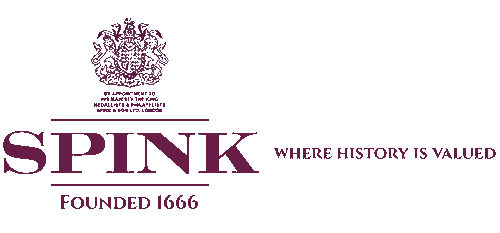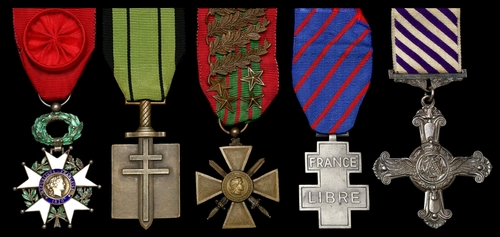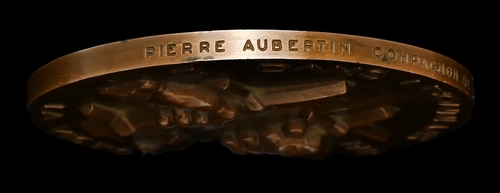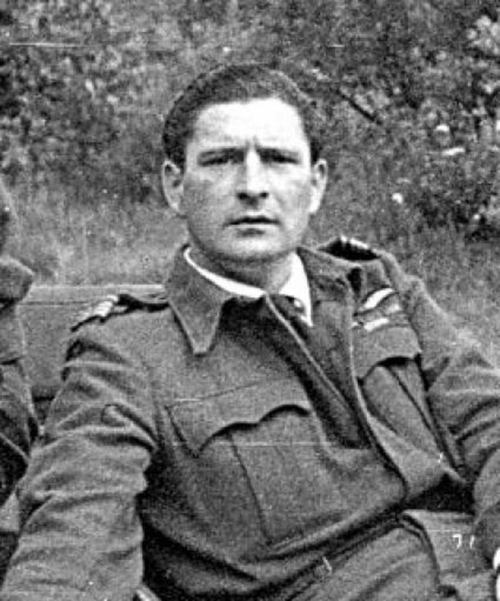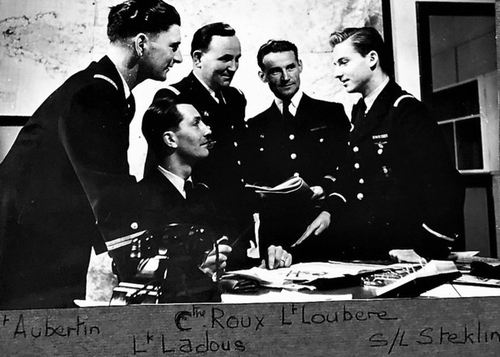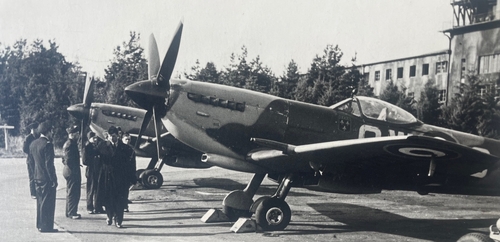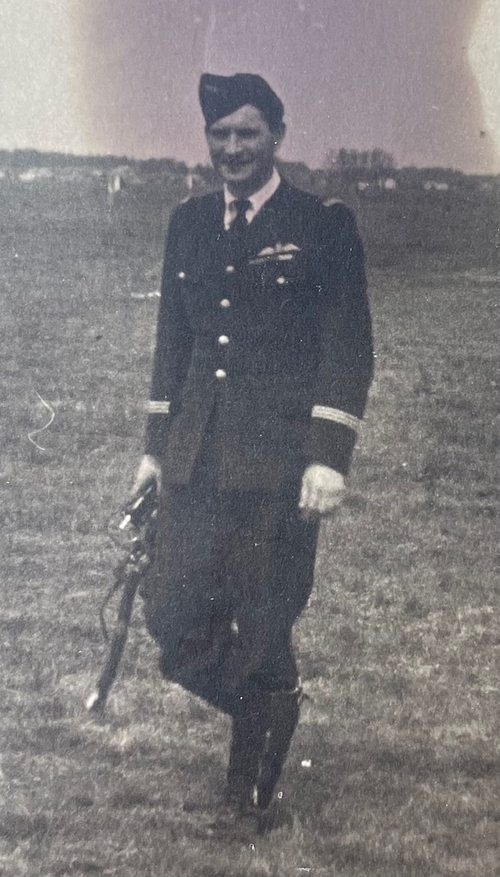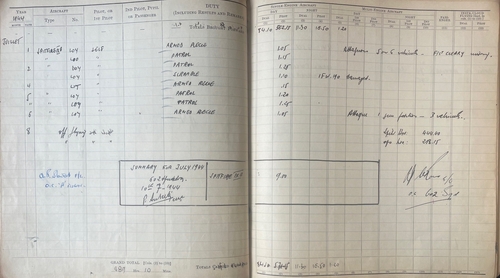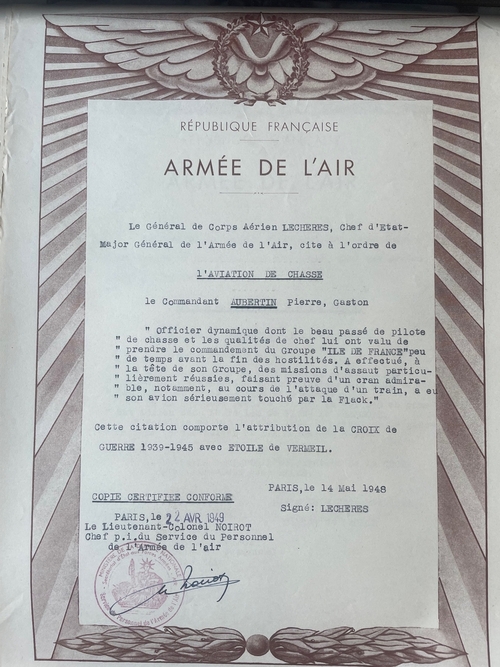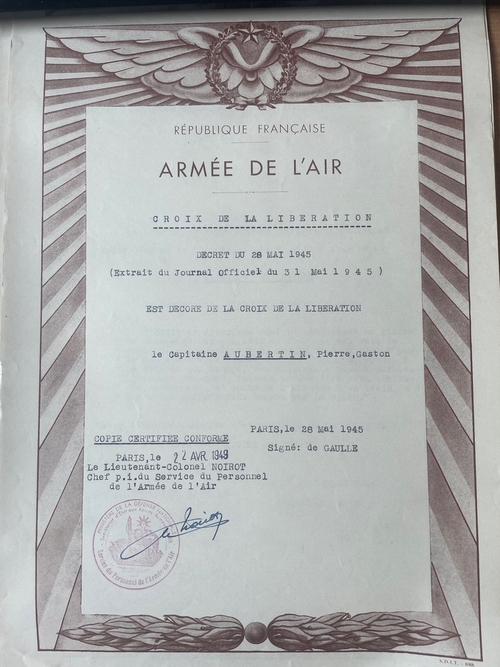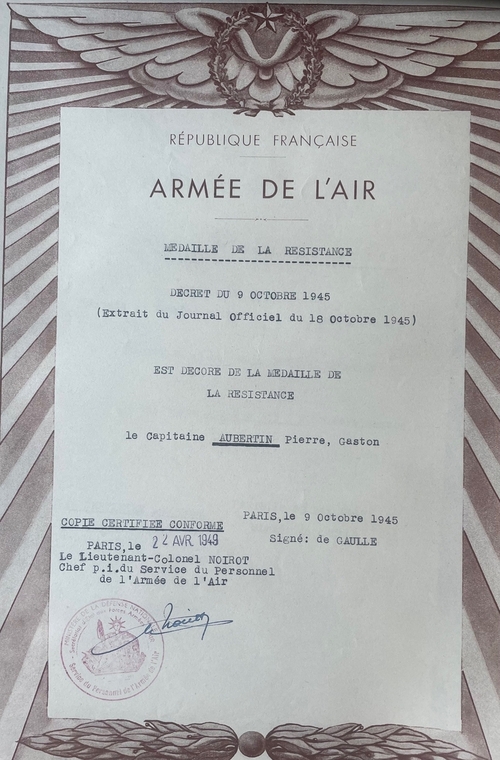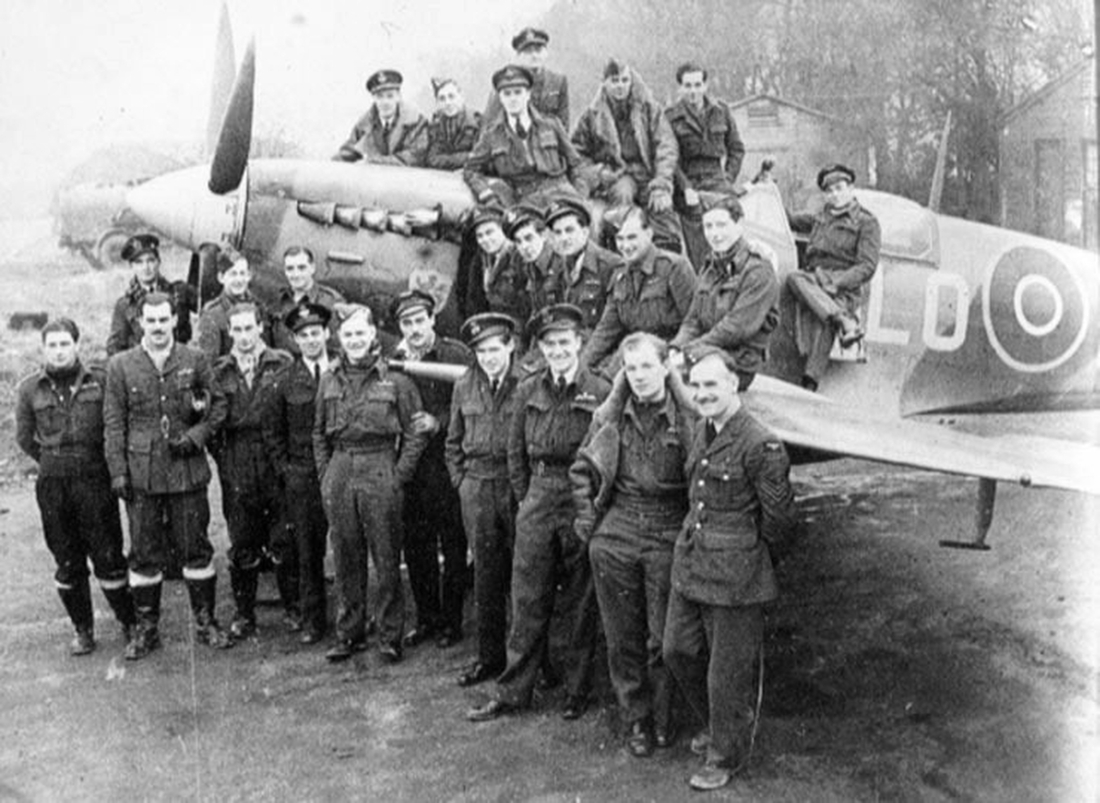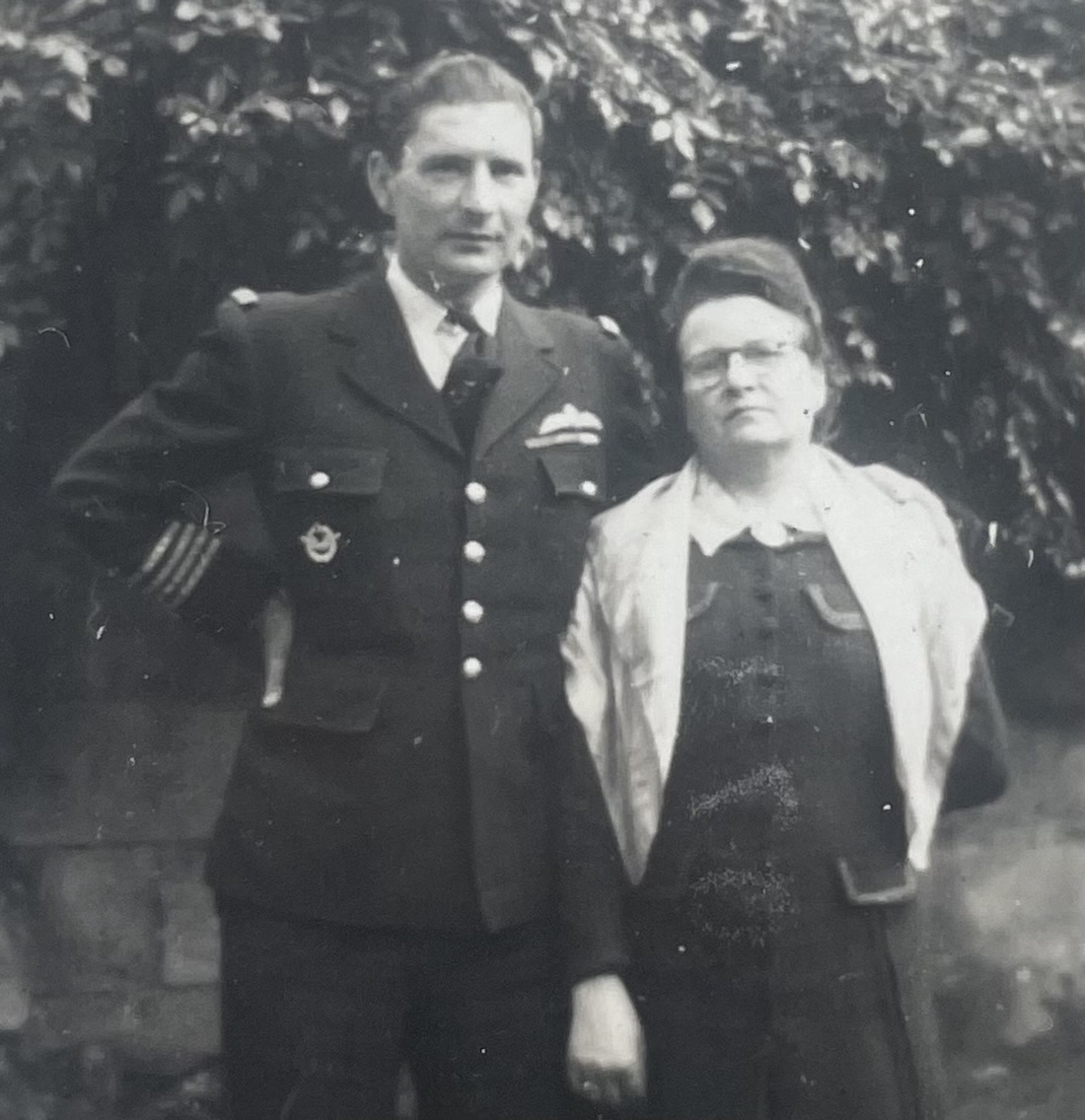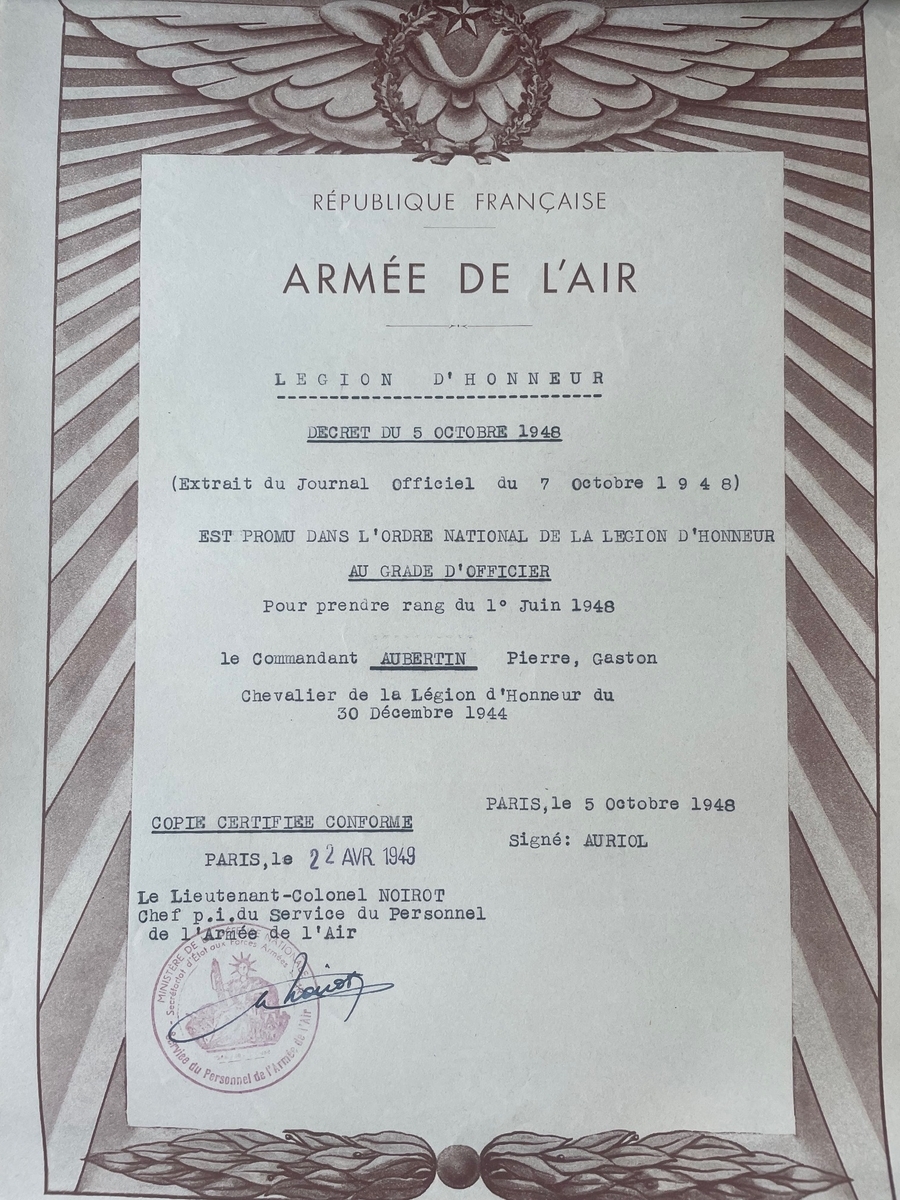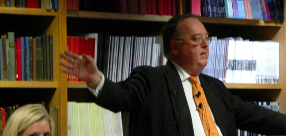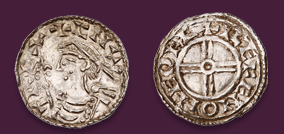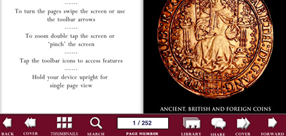Auction: 25003 - Orders, Decorations and Medals
Lot: 221
'I was Blue 1 at 12,000 feet when, turning around, I saw four FW. 190s diving at us. I cleared to starboard and saw that one of the FWs was chasing a pilot from 132 Squadron. I tightened my turn and positioned myself in the tail of the enemy aircraft which was firing on its prey. I opened fire at 600-800 yards to get its attention. The enemy aircraft cleared to the right and dived towards a nearby airfield, possibly Vitry-en-Artois. I followed it, closed to 100 yards, firing at intervals until we were at 800 feet. I fired again and as it was entering a left turn, it suddenly went upside down and disappeared below me. I observed impacts while it was at 3000 feet, then 1000 feet. I claim this aircraft probably destroyed.'
So states the combat report of Capitaine Pierre Aubertin, No. 602 Squadron, dated 21 December 1943.
The outstanding Second World War Spitfire pilot's D.F.C. group of five awarded to Capitaine P. G. J. 'White Shirt or Else' Aubertin, French Air Force, attached Royal Air Force
'As the senior Free French pilot in No. 602 (City of Glasgow) Squadron, his patience was sorely challenged by the high jinks and antics of 'Les Enfants Terrible' - Sergeants Pierre Clostermann and Jacques Remlinger - their failure to adhere to strict uniform protocol causing their 'Capitaine' much frowning
But when it came to combat, all three were deadly serious in their desire kill the enemy, never more so than when news of the Allied landings reached them in the early morning hours of 6 June 1944: on that memorable occasion, the fastidious Aubertin was seen with tears rolling down his cheeks but, 'just this once, he didn't care who noticed'
Indeed, such was his jubilation on landing at a forward airfield in Normandy later that month, he dashed off and purloined several bottles of Calvados
And by the time he was recommended for his D.F.C., he had - over the course of 140 operational sorties - caused the enemy serious strife on the ground and in the air, so much so that General de Gaulle appointed him a 'Compagnon de la Libération'
Distinguished Flying Cross, G.VI.R., the reverse officially dated '1944', in its Royal Mint case of issue and with numbered and named forwarding note; France, Legion of Honour, Chevalier's breast badge, silver and enamel, with rosette on riband; France, Order of Liberation; France, Croix de Guerre, with 4 Stars and 5 Palmes, fitted with undated reverse disc; Free French Forces Cross, together with his Medal of the Companions of the Order of Libertation, bronze, 68mm, obverse, a pair of hands clasping broken crosses, with profile of Joan of Arc's head above, and legend 'Dans l'Honneur et par La Victoire', reverse, a Cross of Lorraine above a broken swastika with the dates '1940 1945' and legend 'Patriam Servando Victoriam Tulit', the edge officially inscribed, 'Pierre Aubertin, Compagnon de la Liberation, 28.5.45', enamel work slightly chipped in places on the second, otherwise good very fine or better (Lot)
The D.F.C. was not announced in the London Gazette, as was the policy for honorary awards to foreign recipients, but surviving Air Ministry and Foreign Office correspondence confirms it was approved in December 1944, having been submitted for approval to The King.
The original recommendation states:
'This officer has shown consistent skill, keenness and determination to destroy the enemy at all times.
He has flown over 140 operational sorties, which have included offensive sweeps and escorts to Mitchells, Bostons and Marauders bombing enemy positions and installations in France and the Low Countries.
Prior to the invasion of France, Captaine Aubertin participated in more than 19 dive bombing sorties on enemy installations and positions in France and the Low Countries, often in the face of intense A.A. opposition.
This officer has also completed three Rangers and has destroyed one FW. 190 and damaged a FW. 190, as well as six enemy transport vehicles.
He has displayed the highest qualities of devotion and loyalty to duty and has shown outstanding qualities of leadership and an offensive spirit which has been an example to all pilots in the squadron.'
The accompanying summary of operations adds:
'Total operational hours: 420.
Total operational hours on tour: 218.
Sorties and sweeps 15.
Dive bombing 20.
Shipping recces 4.
Weather recces 5.
Circuses 57.
Rhubarbs 2.
Patrols 30.'
Pierre Gaston Jules Aubertin was born in Vitry-le-François on 22 March 1915 and, having attended the Military College at St. Cyr, was commissioned as a 2nd Lieutenant in October 1936. Opting for a career in aviation, he joined the French Air Force and qualified for his 'Wings' in November 1939.
Posted to the flying school at Meknes, Morocco in the following year, he and like-minded pilots decided to make for the United Kingdom on the fall of France in June 1940. Using false papers, they flew a shuttle trip to Berrechid airfield, south of Casablanca, took charge of three Martin 167A-3 bombers and headed for Gibraltar. One of them was shot down by Spanish A.A. fire but Aubertin and his aircraft landed safely.
Arriving in the United Kingdom on 15 July 1940, he immediately enlisted in the Free French Forces, but after attending a training course at R.A.F. Odiham in November-December 1940, he was grounded. Firstly, at the central depot at Camberley, and secondly, from March 1941, as an Assistant Staff Officer to the Forces Aériennes Françaises Libres H.Q. in London.
Finally, in early 1942, he was seconded to the R.A.F. and, following further training, was posted to No. 602 (City of Glasgow) Squadron, a Spitfire unit, in January 1943. Here, then, the commencement of a protracted operational career, his first sortie - a convoy patrol - being flown on 4 February, shortly before his promotion to Capitaine.
First blood
As outlined in the recommendation for his subsequent award of the D.F.C., countless offensive sorties ensued, in addition to convoy and bomber escort work. And invariably, from time to time, Aubertin returned to base in a damaged aircraft.
Invariably, too, the squadron fought some memorable combats, Aubertin claiming his first victory in an offensive sweep to Cambrai on 21 December 1943. Thankfully, for posterity's sake, gun camera footage of his 'probable' can today be viewed online at the Imperial War Museum:
'Combat Film No 68. Captain Aubertin of 602 Squadron on 21/12/1943 at 1145, flying Supermarine Spitfire IX. Target: Focke-Wulf FW 190.'
https://www.iwm.org.uk/collections/item/object/1060025446
It is also an action described by the famous ace Pierre Clostermann in The Big Show, for he had joined No. 602 Squadron in September 1943:
'The controller told us there was a strong enemy fighter formation not far off, but it was impossible to spot anything in the dazzling light. To be on the safe side, we gained height again.
Suddenly, woooof! Thirty Focke-Wulfs were on top of us. Before we could move a muscle, the brutes opened fire. A whirlwind of enormous radial engines, of short slender wings edge with lighting, of tracer bullets whizzing in every direction, of black crosses all over the place. Panic. Everyone broke. In the space of one second the two flights' impeccable combat formation was disrupted, dislocated, scattered to the four winds. Too late! Old Jonah was on his way down in flames, and Morgan, the Scots Flight Sergeant, in a spin, one wing torn off by a hail of Mauser.
132 [Squadron] was no luckier. Three of their pilots were shot down. A fourth - as we learnt later - succeeded in bringing his badly damaged machine half way across the Channel, then baled out and was fished out an hour later.
Once the surprise had passed, we pulled ourselves together. Captain Aubertin, in command of Skittles, suddenly found himself isolated: his No. 2 and 4 had been shot down and his No. 3 had vanished into thin air - poor old Spence had got a 20 mm. shell four inches from his head which had smashed his radio to smithereens. Half knocked out, he had instinctively pulled the stick back and opened the throttle, and had woken up at 36,000 feet, absolutely alone in the sky.
A Focke-Wulf sneaked in behind the captain but missed him. The Hun overshot him. He was carried away by his speed and Aubertin settled his hash in no time; the biter bit. Unfortunately four other Focke Wulfs engaged him and not only did he fail to see his victim crash but he himself only succeeded in getting away after an eventful 45-mile chase among the trees, round church steeples and through village streets. His Spitfire was hit seven times.'
Clostermann also refers to Aubertin's aircraft being hit whilst escorting American bombers on a sortie to Belgium on a later date.
D-Day and beyond - Calvados and gunfire
The squadron was regularly on the move over the coming months, and by April 1944 it was hard at work countering the V-weapon offensive, its pilots having taken a crash course in dive-bombing. Aubertin flew around 20 such missions, often in the face of horrendous flak.
But on 1 June 1944, the squadron joined 125 Wing in No. 83 Group, 2nd Tactical Air Force (T.A.F.), a move that ensured it was destined to concentrate on enemy troops and armour during the Normandy landings.
On D-Day itself, Aubertin flew three low-level sorties over the landings, followed up by cover patrols over the bridgehead in the coming days. Then towards the end of the month, on the 25th, the squadron moved to an advanced airfield at Longues-sur-Mer in Normandy. Here, then, the moment Aubertin mounted a sortie of a different nature. Lions Rampant, by Douglas McRoberts, takes up the story:
'The first 'real' night in France was not so much an eye-opener as an eye-waterer. Mon Capitaine [Aubertin], anxious to be as hospitable as possible, vanished in the direction of Bayeux, to return a couple of hours later with several bottles of Calvados. Beaming in the light of a storm lantern in the tent, he withdrew the corks and passed them round. He didn't bother to advise anyone to sip the fiery liquid carefully. Seconds later the tent was nearly whipped from its pegs by a fusillade of coughs, which nearly drowned the noise of gunfire from Caen. They slept soundly.'
And so, the sorties continued apace, ground strafing enemy troops and vehicles. In fact, the citation to one Aubertin's six awards of the Croix de Guerre states that he destroyed eight enemy vehicles in the second half of June, two of which were 'full of troops', in addition to damaging 15 others.
Back in the air, on 2 July, his guns were in action against a formation of FW. 190s, one of which he claimed as damaged. And then, for good measure, he shot up a gun position and three more enemy vehicles on the 7th. Small wonder that 602 later claimed the record for 'flamers'.
Aubertin had now as a frontline pilot for 18 months and, in common with his C.O., Squadron Leader R. A. 'Max' Sutherland, D.S.O., he was grounded, for they had both 'flown their socks off'.
Awarded an honorary D.F.C., Aubertin was also appointed a Chevalier of the Legion of Honour, the citation reading:
'A volunteer from June 1940, an elite officer of high moral and military value, a high class fighter pilot who has led his squadron with great spirit and vigour in combat and commanded competently on the ground. He has more than 120 hours of operational flying time accrued in 110 sorties, distinguished particularly by the probable destruction of a FW. 190 and the damaging of a second. He has destroyed an artillery battery and seriously damaged a ship, in addition to flying 80 offensive patrols of which four were very successful dive-bombing missions.'
Aubertin, moreover, was the recipient of six awards of the Croix de Guerre; see below listed certificates. But his most notable French honour was surely his appointment by General de Gaulle to be a Companion of the Order of Liberation in May 1945, a rare distinction indeed.
Posted to the General Staff of the French Air Force back in London, he took command of No. 340 Squadron in Holland shortly before VE Day, but he remained grounded and later took up an appointment in Versailles.
Advanced to Officer of the Legion of Honour in October 1948, the gallant Aubertin died in a military hospital in Lyons in March 1949, aged just 32.
Sold with a quantity of original documentation, comprising:
(i)
His R.A.F. Pilot's Flying Log Books (2), the first with just a few entries in Magisters at Ford in November- December 1940, and the second covering his entire flying career in the period March 1942 to April 1945.
(ii)
A series of officially stamped certificates (8), as issued to the recipient in Paris in April 1949, comprising those for his Legion of Honour, Chevalier, with citation (awarded December 1944); Legion of Honour, Officer (awarded October 1948); Croix de Guerre, avec etoile de vermeil, with citation (awarded May 1948); Croix de Guerre, avec palme, with citation (awarded November 1944); another similar, but different citation; Croix de Guerre, avec palme, with citation (awarded January 1944); Croix de Guerre, avec palme, with citation (awarded February 1945); Medaille de la Resistance (awarded October 1945), and Croix de la Liberation (awarded May 1945); together with a numbered card in the name of 'Capitaine Aubertin', as issued with his D.F.C.
(iii)
A manual for operating Mercury aircraft, as published by the Bristol Aeroplane Co. Ltd. in January 1938, French edition.
(iv)
Bulletin des Forces Aeriennes Francaises en Grande Bretagne (10), dating from April 1944 to issue No. 20, including references to the recipient.
(v)
A signed, handwritten statement made by Aubertin in London in March 1945, with a counter statement by a French officer.
(vi)
His R.A.F. Ration Card, Flying Clothing Card, Medical Record Card and a voucher for the Grand Hotel, Brussels, dated 28 September 1945.
(vii)
Several wartime photographs and a selection of uniform medal ribands.
Subject to 20% VAT on Buyer’s Premium. For more information please view Terms and Conditions for Buyers.
Estimate
£6,000 to £8,000
Starting price
£4800
